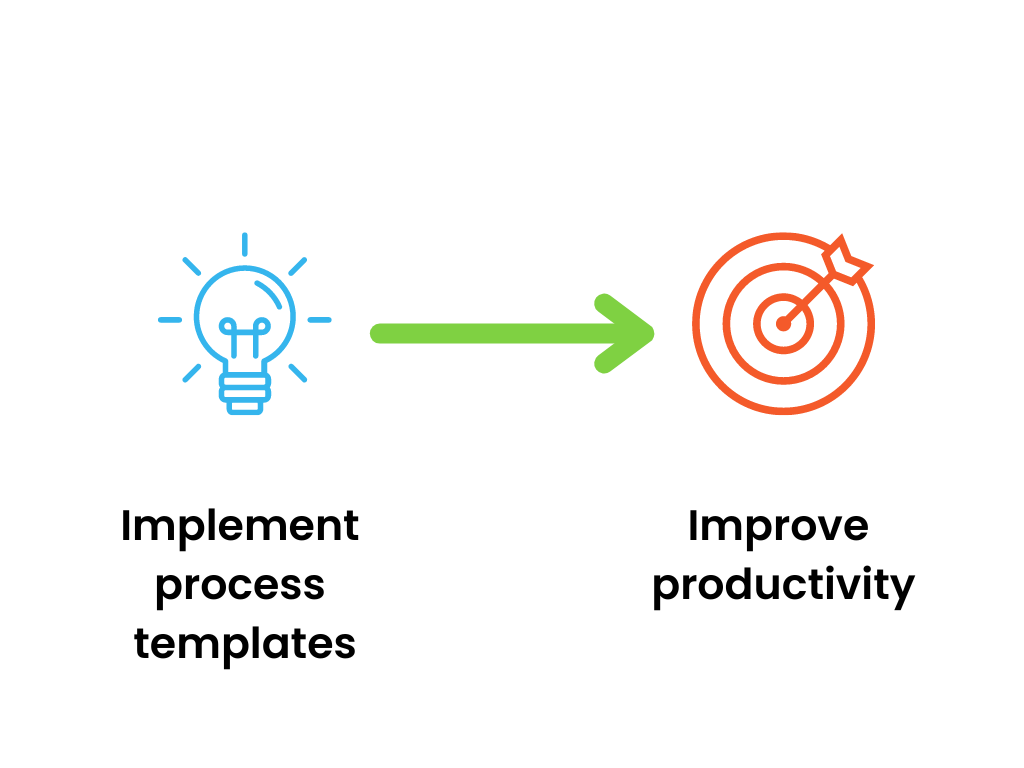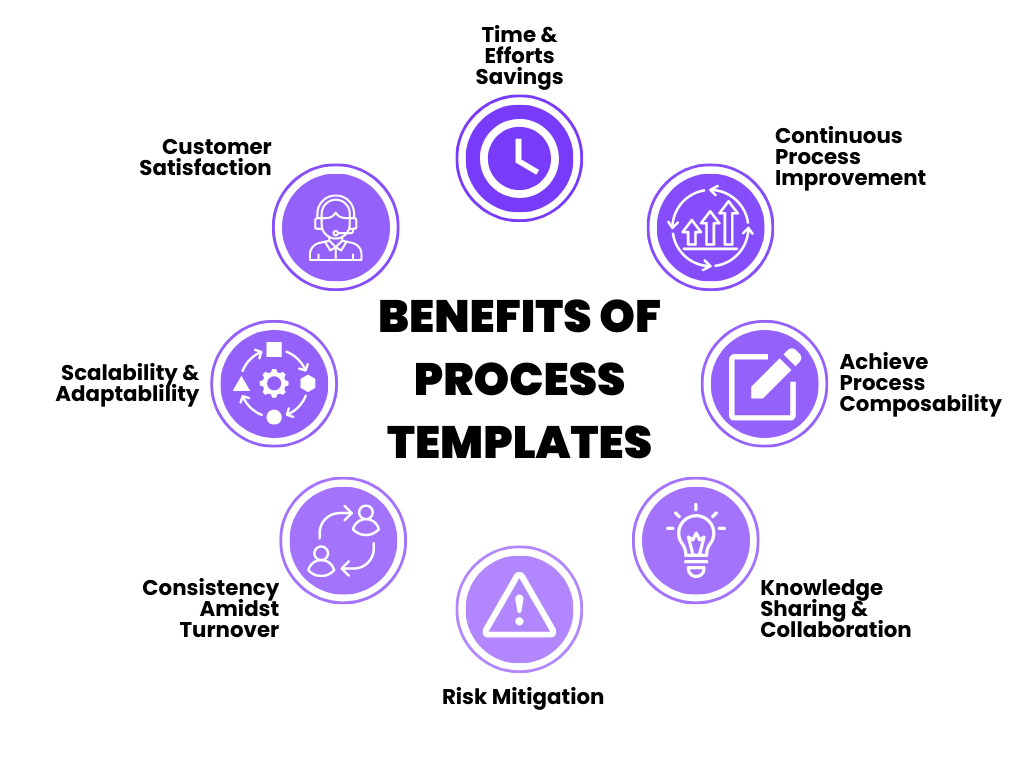Cela fait un certain temps que nous avons annoncé notre Spring Release '23, mais certaines de nos nouvelles fonctionnalités ne vous sont peut-être pas familières. L'une d'entre elles est le modèle de processus.
Qu'est-ce que cela signifie ? Voyons cela de plus près.
Dans cet article, nous aborderons...
- La définition des modèles de processus
- Fonctionnement des modèles de processus
- Comment améliorer la productivité
- Flexibilité et évolutivité
- Les 10 principaux avantages des modèles de processus
Nos modèles de processus sont des plans prêts à l'emploi qui permettent de prendre une longueur d'avance dans la conception et la mise en œuvre de nouveaux processus. Cette fonctionnalité innovante permet de gagner du temps et favorise la cohérence et la collaboration au sein des équipes. Cette fonctionnalité résout un problème professionnel courant : passer trop de temps sur les petites tâches répétitives et pas assez sur les grandes. Les modèles de processus réduisent considérablement le temps consacré aux tâches.
Comment fonctionnent les modèles de processus ? Un point de départ sans faille
L'automatisation des processus métier (BPA) comprend des dizaines de points de contact. Il peut être nécessaire d'impliquer des membres de l'équipe, de se connecter à des logiciels tiers ou d'organiser un escadron de robots RPA. Faire table rase à chaque fois peut s'avérer chronophage, frustrant et risqué.
Avec les modèles de processus de ProcessMaker, vous pouvez rapidement réutiliser des processus existants que vous avez déjà vérifiés.
Comment cela fonctionne-t-il ? Lorsque vous ouvrez le Process Modeler dans ProcessMaker Platform, vous pouvez choisir parmi différents modèles prédéfinis.
Ces modèles couvrent un large éventail de processus opérationnels, tels que l'accueil des employés, le traitement des factures, la gestion des congés, etc. Ces modèles décrivent les entrées, les sorties, les rôles, les responsabilités, les points de décision et les étapes nécessaires à l'exécution d'un processus spécifique.
En choisissant un modèle qui correspond étroitement à l'objectif commun de votre organisation, vous pouvez lancer la phase de création du processus. Les modèles servent de base solide et fournissent une structure et un flux que vous pouvez adapter à vos besoins spécifiques.
Outre les modèles définis dans ProcessMaker Platform, nous disposons également d'une collection croissante de modèles gratuits. Vous pouvez utiliser ces modèles pour démarrer votre prochain projet. Vous les trouverez dans notre Galerie de modèles.
Comment les modèles de processus améliorent la productivité
Une étude réalisée par Asana a révélé que les employés perdent environ 4 heures et 38 minutes chaque semaine à refaire un travail qui existe déjà. Cela signifie refaire des rapports dont ils ignorent que quelqu'un d'autre les a déjà rédigés. Poser des questions auxquelles on a déjà répondu. Retourner à la planche à dessin au lieu d'utiliser une stratégie préexistante.
C'est ici que les modèles d'automatisation des processus peuvent réellement aider votre équipe. Au lieu de travailler de manière régressive, les employés et les équipes collaboratives peuvent passer plus de temps à aller de l'avant.

Un modèle de processus peut inclure les tâches nécessaires pour :
- Ouvrir un nouveau compte
- Consulter les coordonnées d'un client dans un ERP
- Embarquer ou débarquer un employé
- Traiter une facture
- Traiter un formulaire ou une demande entrant(e) à l'aide du traitement intelligent des documents
- Attribuer une piste de vente
- Générer un rapport
- Exécuter une commande
- Vérifier les dépenses d'un employé
- Procéder à un examen des performances
- Gérer un nouveau contrat
- Prendre rendez-vous avec un technicien
- Soumettre une demande de congé annuel ou une demande CapEx à un responsable
Au lieu de tout recommencer, les membres de l'équipe peuvent reprendre le processus approuvé et l'intégrer dans un nouveau processus.
Supposons par exemple que vous disposiez d'une séquence de tâches guidant votre équipe de service à la clientèle dans l'ouverture de nouveaux comptes par téléphone. Mais vous souhaitez ajouter une option de libre-service que les utilisateurs peuvent remplir à leur guise. Les modèles de processus vous permettent de prendre une longueur d'avance en utilisant des étapes dont vous connaissez déjà le fonctionnement. Vous pouvez ensuite les adapter à un objectif similaire mais nouveau.
Flexibilité d'enregistrement et de réutilisation pour une collaboration sans faille
Les modèles de processus ne se contentent pas de proposer des modèles prédéfinis ; ils vous permettent d'enregistrer vos propres processus en tant que modèles.
Après avoir créé ou modifié un processus, vous pouvez l'enregistrer en tant que modèle que vous pourrez réutiliser à l'avenir. Grâce à cette fonctionnalité, les organisations peuvent créer une bibliothèque de modèles personnalisés qui correspondent à leurs exigences commerciales et à leurs processus opérationnels uniques.
Lors de projets futurs, les utilisateurs peuvent utiliser ces modèles sauvegardés, ce qui réduit considérablement le temps et les efforts nécessaires à la création de processus. Cette fonctionnalité rationalise la distribution des meilleures pratiques et favorise la collaboration, où les employés peuvent librement partager et mettre en œuvre des idées d'amélioration des processus.
Les 10 principaux avantages des modèles de processus
L'objectif principal des modèles de processus dans la gestion des processus d'entreprise (BPM) est d'améliorer la normalisation, l'efficacité et la qualité. Grâce à un haut niveau de cohérence, vous pouvez réduire la confusion, les erreurs et les variations involontaires dans vos processus les plus importants. Voici les 10 principaux avantages de l'utilisation des modèles de processus dans la plate-forme ProcessMaker :

1. Économies de temps et d'efforts: Une fois que vous avez trouvé le bon modèle, pourquoi réinventer la roue ? Les utilisateurs peuvent simplement choisir un modèle qui correspond à leurs besoins et le personnaliser en conséquence. Cela accélère les premières étapes de la création du processus et libère du temps et des ressources précieuses pour d'autres tâches essentielles.
2. Amélioration continue des processus: Les modèles de processus vont de pair avec l'épine dorsale de l'élaboration de processus efficaces : l'amélioration des processus. Les tests et l'analyse continus rendent les processus plus efficaces. En utilisant les blocs de construction existants, vous pouvez itérer à plusieurs reprises jusqu'à ce que vous ayez trouvé la séquence de tâches la plus performante.
3. Réaliser la composabilité des processus: Avec les modèles de processus, les rouages de votre machine à processus existent en tant que composants individuels. Vous pouvez facilement échanger et réutiliser des parties de votre flux de travail pour créer de nouveaux processus. Les utilisateurs peuvent éviter les pièges les plus courants et concevoir des processus optimisés pour la réussite en s'appuyant sur des modèles prédéfinis.
4. Partage des connaissances et collaboration: La possibilité d'importer et d'exporter des modèles facilite le partage des connaissances et la collaboration entre les membres de l'équipe. Les utilisateurs peuvent profiter de l'expertise de leurs collègues en important des modèles créés par d'autres, ce qui permet une amélioration continue des processus. En outre, l'exportation de modèles permet aux organisations de normaliser les processus au sein de différentes équipes, départements et pays.
5. Atténuation des risques: Éliminer la probabilité d'erreurs et de retards. Lorsque tous les membres de l'équipe utilisent des modèles préapprouvés, les risques que les nouveaux processus rencontrent des problèmes inattendus sont réduits.
6. Cohérence au milieu de la rotation: Toutes les entreprises ont du mal à maintenir une base de connaissances institutionnelle. Lorsqu'un membre clé de l'équipe part, les équipes se grattent souvent la tête, ne sachant pas exactement comment accomplir des tâches essentielles. Les modèles de processus permettent de s'assurer que personne ne part avec la recette "comment faire" enfermée dans sa tête. Vous disposerez ainsi d'un enregistrement fiable des meilleures pratiques dans lequel vous pourrez puiser lorsqu'il s'agira de créer de nouveaux processus automatisés.
7. Évolutivité et adaptabilité: Au fur et à mesure que les organisations se développent et évoluent, leurs exigences en matière de processus peuvent changer. Les modèles de processus offrent la flexibilité nécessaire pour s'adapter à ces besoins changeants. Les utilisateurs peuvent facilement modifier les modèles ou en créer de nouveaux en fonction de l'évolution des besoins de l'entreprise. Cette évolutivité garantit que les processus s'alignent sur les objectifs de l'organisation et permet d'effectuer les ajustements nécessaires.
8. Maintenir la conformité réglementaire: Les modèles de processus sont une fonctionnalité BPM vitale pour les industries qui ont des exigences élevées en matière de conformité. En suivant les modèles existants, les organisations peuvent systématiser les règles et les règlements entre les équipes. Les modèles peuvent inclure des points de contrôle de la qualité, des règles d'accès des utilisateurs et des indicateurs de performance afin que tous les processus suivent les mêmes critères.
9. Amélioration de la formation des employés: Les modèles de processus constituent une ressource précieuse pour la formation des nouveaux employés. Les nouveaux arrivants peuvent se référer aux modèles pour comprendre les étapes, les tâches et les rôles impliqués dans les différents processus dont ils ont la charge. Cela réduit la courbe d'apprentissage et garantit que les nouveaux employés suivent les procédures établies dès le début.
10. Une satisfaction de la clientèle très élevée: Selon McKinsey, la "cohérence" est l'ingrédient secret du bonheur des clients. Lorsque les clients s'engagent avec votre marque, ils aiment savoir à quoi s'attendre. Qu'il s'agisse de payer une facture ou de mettre à jour les détails d'un compte, la cohérence est essentielle. Les modèles d'automatisation des processus établissent une expérience fiable qui renforce la confiance de votre base d'utilisateurs.
Comment l'IPA stimule-t-elle l'hyperproductivité ?
L'automatisation intelligente des processus (IPA) peut changer la donne pour votre organisation à plus d'un titre. L'une des façons les plus significatives de transformer votre flux de travail est de stimuler l'hyperproductivité. Au lieu d'être simplement productive, votre équipe peut devenir hyperproductive, en accomplissant son travail plus rapidement et plus efficacement que jamais.
Vous essayez de trouver le bon logiciel pour les besoins de votre organisation ? Nous sommes là pour vous ! Discutez avec notre équipe pour trouver le logiciel qui convient le mieux à votre entreprise (même si ce n'est pas nous !).






